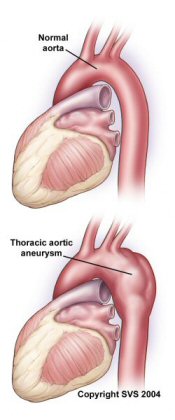Aortic Disease
Untreated, a diseased aorta can burst or tear (dissection), an often-fatal outcome. Recent data from the National Center for Health Statistics reports 15,000 people die annually from an aortic aneurysm or dissection. The optimal treatment plan for aortic disease calls for skilled monitoring and appropriate surgical management of the condition.
Aortic diseases include:
Aortic Aneurysm
An abnormal bulge in the wall of the aorta, typically to twice its normal size or larger. Because the bulge is a weakness the aorta may rupture, causing life-threatening internal bleeding. The major causes of aortic aneurysm are smoking, hypertension and family history.
 Aortic Dissection
Aortic Dissection
A longitudinal tear of the inner layer of the aortic wall, allowing blood to leak into the wall itself and cause separation of the inner and outer layers. It is usually associated with severe chest pain radiating to the back. Unlike aneurysms that develop over time, a dissection happens spontaneously. The major causes are Marfan's Disease, bicuspid aortic valve, and hypertension.
Type A Dissection
These begin in the ascending aorta, typically just above the coronary arteries, and are life threatening. At this point the aorta is the largest and thinnest. It lacks support from surrounding structures and experiences the greatest amount of wall tension. They are always treated as a surgical emergency.
Type B Dissection
Involves the descending aorta and is typically stabilized medically to start. However, if complications with blood flow to the lower body arise, the patient will require an interventional procedure.
Atherosclerosis
Known commonly as "hardening of the arteries," atherosclerosis is caused by high blood pressure and a buildup of cholesterol and fat within the artery. The condition can damage the aortic wall and reduce the vessel's flexibility.
Aortic Inflammation
Inflammatory diseases may block the flow of blood through the aorta and weaken the aortic wall.
Connective Tissue Disorders
Patients with Marfan Syndrome, Ehler-Danlos syndrome, and other genetic connective tissue disorders have weak aortic walls that can rupture or tear. Early detection, monitoring and treatment of aortic disease including appropriately timed elective surgery, are key. Conditions affecting the aorta are serious, but through expert diagnosis and treatment, lifestyle modifications and ongoing medical supervision, patients under the care of aortic specialists are in the best position to continue to enjoy normal, productive lives.

